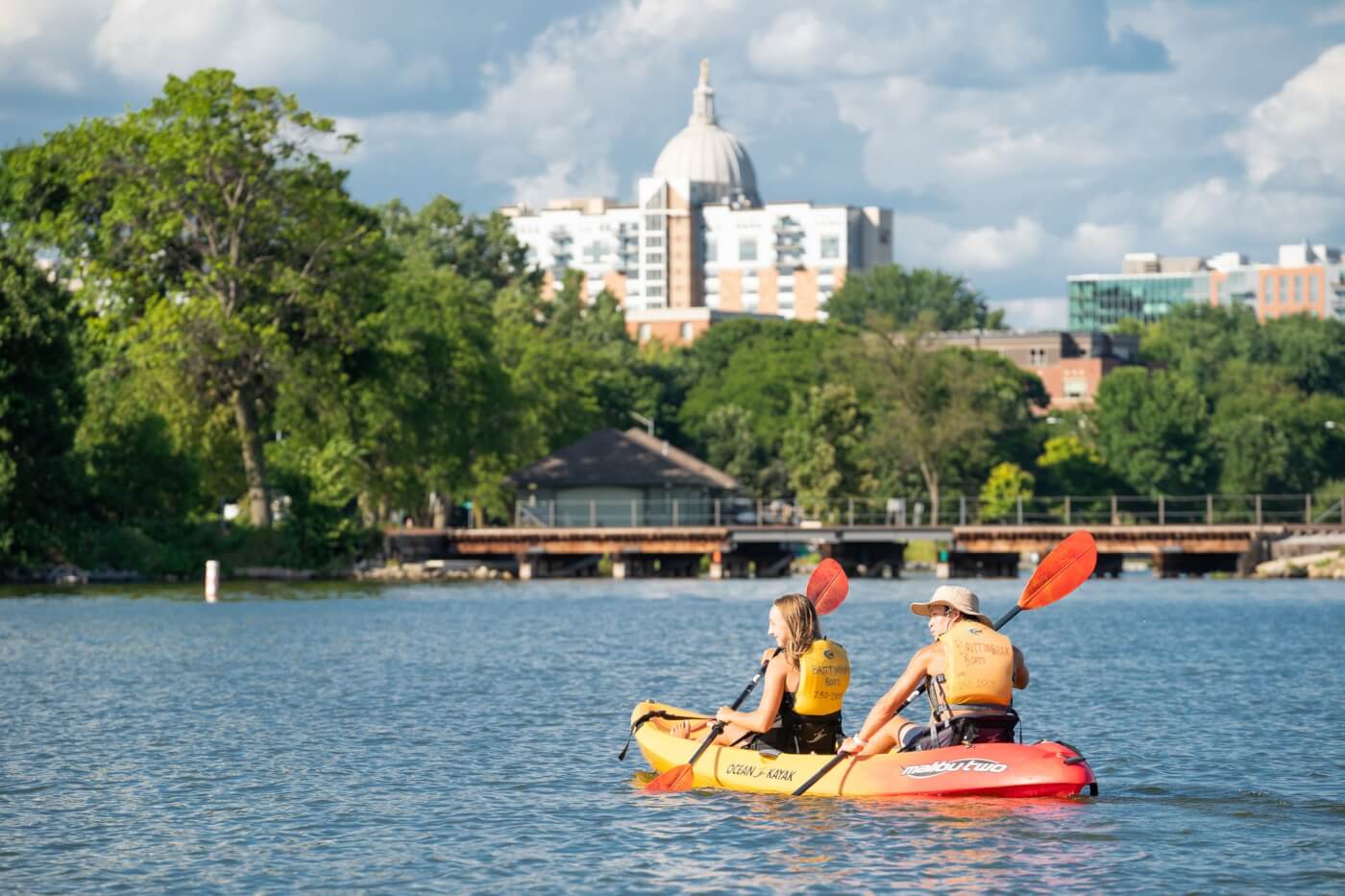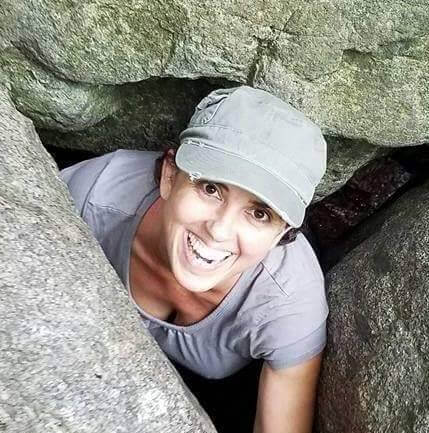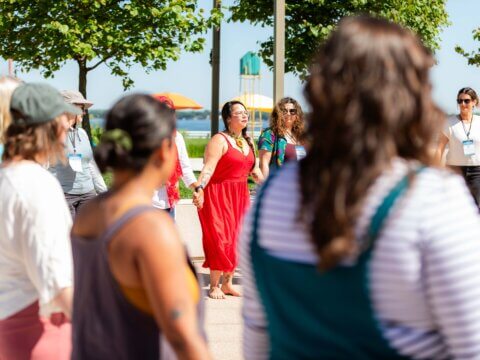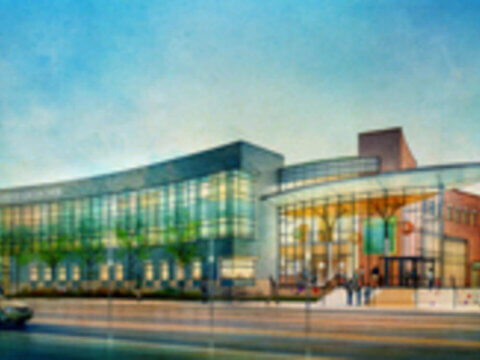A history of collaboration in Madison brings nature everywhere children live, learn and play
At the Olbrich Botanical Gardens in Madison, Wisconsin, a high school student points to a banana plant in awe, mouth open wide, and says, “This is where bananas come from? What?” Tanya Zastrow, Executive Director of the Gardens, nods and laughs. As she continues the tour, she watches the students’ amazement as they experience things in nature they haven’t seen before. One young woman exclaims, “This is my new favorite place!” It’s scenarios like this that remind Zastrow of why she’s in the “business of providing emotional souvenirs,” as she likes to say.
“We don’t often know what impact we are having with young people,” Zastrow said. “But I know we are helping them make the connection between themselves and the natural world, helping them understand the world around them. That joy of seeing and learning makes it worthwhile.”
This sentiment — an understanding of the importance of connecting young people to nature in their daily lives — runs deep in Madison, Wisconsin. From the city’s parks division to the health department to the school district to the Mayor’s office to local community organizations and nonprofits, they all work to create opportunities for children to engage with nature and nature-based experiences.
This cross-sector dedication to nature access helped secure Madison’s selection as one of the inaugural 19 Nature Everywhere Communities in 2023. As an example, the Madison Nature Everywhere Community team (Madison team) is a collaboration between Public Health Madison & Dane County, the City of Madison, Aldo Leopold Nature Center & Nature Net, Olbrich Botanical Gardens within Madison Parks, and Madison Metropolitan School District.
But, Madison has a long history of cross-sector engagement in nature-based solutions. For 20 years, many of the city’s nature centers, parks and museums have coordinated outdoor education programs through the Nature Net network. The city also joined the Cities Connecting Children to Nature (CCCN) initiative in 2016.
In 2016, the CCCN Madison team brought partners together from across various sectors to advance several children and nature strategies. The partners implemented seven nature play spaces in child care centers with the potential to get 200 children into nature daily. The CCCN partners executed a community assessment of nature access and outdoor education infrastructure. And, they engaged young people in a community outreach project to gain a better understanding of how the local community views nature access.
Public Health Madison & Dane County created this video in 2016 after the city joined the CCCN initiative to show its commitment to providing all children with opportunities to spend time in nature.
When the COVID-19 pandemic hit, the city’s limited staff resources were redirected to public health emergency response efforts. Staffing focused on connecting children to nature became limited, but the commitment to this work remained. It is now reignited through Madison’s participation as a Nature Everywhere Community.
Today, the newly formed Madison team plans to pick up where CCCN left off, with an understanding that this work cuts across and should be integrated into many different aspects across the city. As the Madison team likes to say, they want to “share the privilege of doing this work” — that is, the work of ensuring that all children grow up with the many proven benefits of nature.
“We talk about parks a lot because that’s a natural way to go. But that’s not the only way to increase access to nature. The schools are an obvious other solution,” said Justin Svingen, Public Health Planner for the Public Health Madison & Dane County and the team lead for the Madison Team. “For years we’ve talked about nature as a spectrum. It’s our street trees. It’s the way we design our buildings. It’s the programming that different places utilize. It can be incorporated into workforce wellness and early childcare. There are a lot of ways of incorporating it and connecting it to the amenities we have in our community.”
Luckily for Madison, many organizations and sectors work in the shared space of nature access. Because of this, the Madison team is aware of the need for deliberate and strategic coordination. They want to create a shared vision for the region, one that helps everyone work together towards common goals.
“We have so many people who are doing great work and are motivated. What we are looking towards now is to create shared language about what we are doing and why,” said Betsy Parker, Executive Director of Aldo Leopold Nature Center and Nature Net, and a core member of the Madison team. “A shared vision will provide all of us in this space with a north star. This will help ensure it’s not just everyone doing their work in a silo or in scattered directions, but we are all coming together and focusing jointly on some key projects with a shared focus.”
The details of those projects and the team hopes will be co-created with the various partners, as well as with local youth and community input. The team wants to figure out where the gaps exist and what everyone can do together to fill those gaps. As Parker said, “What’s most important is that this is community-owned.”
Some of this work, of understanding the gaps, was started with CCCN and its community assessment to better understand nature access. Madison has excellent access to parks: 13.4% of all land in the City of Madison is dedicated to parks, and the distance from any Madison public school to a city park is just 0.17 miles. And yet, the CCCN assessment found there are still significant barriers to equitable use along racial lines.
The CCCN assessment revealed that some residents still feel reluctant to let their children use certain natural areas, while others said they do not feel welcome and feel like they do not belong in nature. The report stated that Madison’s disparities require deliberate strategies to improve health and racial equity, including increasing equitable opportunities for children and families of color to spend time in nature. While programs are plentiful, the report said they are often not coordinated very well, and continue to have barriers to participation and enrollment, particularly for children of color.
“We score very well on metrics when it comes to nature, outdoors and health, but once you disaggregate you see a different story,” said Svingen. “It’s not the same story for everyone, and it’s often people of color that are experiencing these outcomes differently. We begin to see health inequities along racial lines early in life.”
This is why the Madison team is committed to incorporating the benefits of time in nature for all children in Madison, and particularly for children who have traditionally been excluded from the benefits of nature access, children of color and children experiencing poverty. The team believes it is essential to incorporate the community’s input to understand how to ensure that people of color feel welcome and included in Madison’s natural spaces.
“The City of Madison is excited to be a part of the Nature Everywhere program. We’ve been doing the work to get kids into nature for a long time and are happy to continue it via this partnership with the Public Health Madison & Dane County, Olbrich Botanical Gardens, Aldo Leopold Nature Center, Nature Net, and the Madison Metropolitan School District. By working in collaboration, we are taking tangible steps towards ensuring that every resident, regardless of background or circumstance, has equal opportunities to connect with and benefit from the natural world.”
– Mayor Satya Rhodes-Conway
Zastrow, who is also a core member of the Madison team and whose position is within Madison Parks, said that while the city has a lot of parks and playgrounds, the challenge for Madison Parks is activating those parks in a way that feels inclusive and welcoming to all.
“One of the goals of Madison Parks is to make sure that those spaces are getting used, that people know that the parks are there for them, and that everyone feels welcome,” said Zastrow. “So how do we make our partnerships stronger and bigger to activate our parks more for everyone?” Parks Alive is an example of a newly created program that connects neighborhoods to their local parks. Residents connect with their neighbors in their local neighborhood park while enjoying music, food, activities and more.
Madison’s Park Superintendent Erick Knepp understands this need for community input and collaboration. As Knepp often says, “The future of parks is partnerships.”

Photo credit: Madison Parks, Parks Alive
“The issue isn’t so much about building new stuff. It’s about adapting those places to include diverse perspectives in the decisions about their use and ensuring that everyone can see themselves in those spaces. When we think about a north star, that’s a big part of it,” said Svigen.
The Madison team sees so much potential, so much goodwill and so many partnerships already in place, that they hope to solidify this work as an official part of the region’s priorities. For the team, in order to make this work sustainable, they believe Madison needs a dedicated staff person.
“We see having a dedicated person as such an important next step,” said Parker. “That person not only keeps the train on the track, keeps the momentum going in the right direction, but also creates the structure that can be more permanent. Even if the person were to leave and a new person comes in, the systems and structures are there to support it.”
The Madison team points to other cities that have accomplished what they hope to achieve in pulling together a large coalition focused on a shared mission. Those who have been successful in coordination of numerous partners, from San Francisco, California to Austin, Texas, and even the state of Texas, have had a dedicated staff person focused on this effort. They want to “institutionalize the backbone of the efforts,” as Svingen said, in order to ensure their sustainability into the future.
“Collectively if we were more organized and focused, we’d be able to make a bigger collective impact, whether that’s on policy or more opportunities or whatever the community needs,” said Zastrow. “We are looking to strengthen ourselves and our current efforts so we can have a bigger collective impact for all children in our community.”
“The list of dedicated partners is quite long,” Svingen said. “This makes us all believe we can really do something with this work.” Through the Madison Nature Everywhere team, the region is truly exemplifying the saying, “Where there’s a will, there’s a way.”
Much of Madison’s work will be available for hundreds of children and nature advocates to see as the city is hosting the Children & Nature Network’s Nature Everywhere Conference, a networking and professional development event, from May 28 to 31, 2024. The city will also host Nature Everywhere Day on Saturday, June 1 from 9 am – 3 pm for the local Madison community to get outdoors and enjoy nature together.
The City of Madison engaged local youth through a summer internship program to help execute many of their children and nature goals, including increasing nature programming to children throughout the city, supporting local gardening and outreach programs, and adding nature play elements to local parks.
How local leaders can improve the quality of life for all children through nature access, a National League of Cities CitiesSpeak article
Cities Connecting Children to Nature (CCCN)
-
Network News
POLICY UPDATE: Policy and advocacy for the children and nature movement
-
Voices
Binoculars, bald eagles and my journey as a Black birder
-
Richard Louv
THE WONDER BOWL: Ten Spring and Summer Nature Activities for Kids and Adults
-
Network News
Minneapolis Spotlight: The promise and possibilities of parks for youth
-
Voices
Why nature is my motherhood ally






